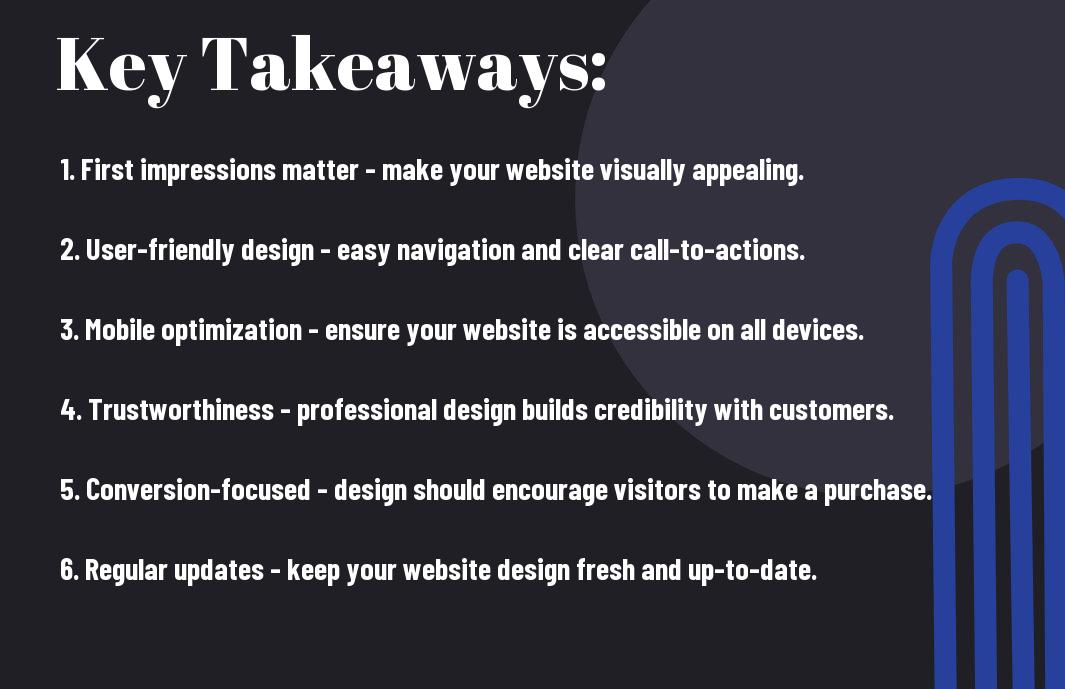You may not realize it, but the design of your e-commerce website plays a crucial role in the success of your online business. An effective and visually appealing website can attract customers, increase sales, and build trust with your audience. On the other hand, a poorly designed website can drive potential customers away and harm your business reputation. Your website design sets the tone for your brand and can make or break your e-commerce success. In this blog post, we will explore the importance of good website design and how it can significantly impact your e-commerce business. Whether you’re a beginner or have been in the e-commerce game for a while, understanding the role of website design is essential for your business growth.
Key Takeaways:
- User Experience (UX) is critical: A well-designed website enhances user experience, making it easier for customers to navigate, find products, and ultimately make purchases.
- Mobile optimization is essential: With the increasing use of mobile devices for online shopping, ensuring a responsive design that works seamlessly across different screen sizes is crucial for e-commerce success.
- Visual appeal influences purchase decisions: Visually appealing and professional design can help build trust and credibility with customers, ultimately leading to increased sales and customer loyalty.
- Intuitive navigation boosts conversion rates: Clear navigation and easy access to important information can lead to higher conversion rates, as customers are more likely to explore the website and make a purchase.
- SEO-friendly design is important: A well-optimized website design can improve search engine rankings, driving more organic traffic and increasing visibility for e-commerce businesses.

Establishing Brand Identity
Now, let’s talk about the importance of establishing a strong brand identity through your website design. Your e-commerce website is often the first point of contact between your brand and potential customers. This means that the design elements and overall aesthetic of your website play a crucial role in shaping the perception of your brand and creating a lasting impression on visitors.
Design Elements That Reflect Brand Values
When it comes to establishing your brand identity, the design elements on your website should reflect your brand values and messaging. This includes your color scheme, typography, imagery, and overall visual style. Consistency in these design elements is key to creating a cohesive and memorable brand identity. Every aspect of your website design should align with and reinforce your brand’s values and personality, helping you stand out in a crowded e-commerce landscape.
Creating a Memorable First Impression
Your website’s design is also crucial in making a memorable first impression on visitors. Within the first few seconds of landing on your site, potential customers will form an opinion about your brand based on the visual appeal and user experience of your website. This is why it’s essential to focus on creating a visually compelling and user-friendly design that captures the attention of your audience and conveys the essence of your brand at a glance. Your website’s design should draw visitors in and make them eager to explore your offerings further.
Enhancing User Experience
To ensure a successful experience for your customers, it is crucial to focus on enhancing the user experience of your e-commerce website. This involves various elements such as website design, functionality, and usability. To further understand the importance of user experience in e-commerce, you can read more about The Role of Web Development in E-Commerce.
Website Navigation and Structure
When it comes to enhancing user experience, easy website navigation and a clear website structure are key factors. You want to make sure that your website is easy to navigate, and that users can quickly find what they are looking for. Additionally, a well-structured website can help improve your conversion rate by guiding users smoothly through the sales funnel.
Visuals and Content Layout
The visuals and content layout of your e-commerce website play a significant role in captivating and retaining your audience. Eye-catching visuals and a clean, organized content layout can enhance the overall aesthetics of your website and keep visitors engaged. Utilizing high-quality images, videos, and well-placed content can also positively impact your brand identity and leave a lasting impression on your visitors.

Website Functionality and Performance
Not only does the design of your e-commerce website have to be visually appealing, but it also needs to be highly functional and perform well. The functionality and performance of your website are crucial to the overall success of your online business. If your site is difficult to navigate, slow to load, or unresponsive, you risk losing potential customers and damaging your brand’s reputation.
Mobile Optimization and Responsive Design
When it comes to e-commerce, mobile optimization and responsive design are absolutely essential. With a rapidly growing number of people using mobile devices to shop online, failure to optimize your website for mobile can result in a significant loss of potential customers. A responsive design ensures that your website is accessible and easy to use on all devices, regardless of screen size, providing a seamless and satisfying shopping experience for your customers.
Speed, Accessibility, and User Retention
Speed is crucial for the success of your e-commerce website. Your customers expect your web pages to load quickly, and if they experience delays, they are likely to abandon your site and seek out a faster alternative. In addition to speed, accessibility is also key. Your website must be easy to navigate, with clear, intuitive navigation and search functionality. User retention is directly linked to the speed and accessibility of your site; the easier it is for customers to find what they are looking for, the more likely they are to stay and make a purchase.
Conversion Optimization Strategies
Despite the importance of attracting visitors to your e-commerce website, the ultimate goal is to convert those visitors into customers. To achieve this, you need to implement conversion optimization strategies that focus on improving the user experience and encouraging visitors to take the desired action. For more information on the role of the website in the e-commerce industry, check out this Role of the Website in E-Commerce Industry blog post.
Call-to-Action Placement and Design
When it comes to maximizing conversions on your e-commerce website, the placement and design of your call-to-action (CTA) buttons play a crucial role. You need to strategically position CTAs throughout your website, making them prominent and visually appealing. Use compelling language and visually striking design to entice visitors to take action and make a purchase. Remember that your CTAs should be clear, concise, and easily accessible to guide users towards the desired action.
Trust Signals and Customer Reassurance Elements
Establishing trust with your potential customers is essential in e-commerce. Including trust signals and customer reassurance elements on your website can boost confidence and encourage visitors to make a purchase. Display trust badges, customer testimonials, and secure payment logos prominently on your site. You can also include a money-back guarantee and clear return policy to eliminate any doubts in the minds of your potential customers. Building trust through these elements can increase conversions and contribute to long-term customer loyalty.
The Role of Website Design in E-Commerce
Presently, you now understand the crucial role that website design plays in the success of an e-commerce business. The design of your website directly impacts the user experience, which ultimately determines whether or not a visitor converts into a customer. It is important to prioritize a clean and intuitive design, easy navigation, and responsive functionality to ensure that your e-commerce website effectively engages and converts visitors. In addition, incorporating persuasive visual elements and strategic placement of calls to action can further enhance the impact of your website design on the overall success of your e-commerce business. By recognizing the significance of website design in e-commerce, you can effectively leverage it to maximize your online business’s potential for growth and profitability.
FAQ
Q: What is the role of website design in e-commerce?
A: The role of website design in e-commerce is crucial as it directly impacts user experience, conversion rates, and overall success of the online business. A well-designed website can attract and retain customers, while a poorly designed one can drive them away.
Q: How does website design affect user experience in e-commerce?
A: Website design greatly affects user experience in e-commerce by influencing how easy it is for customers to navigate, find products, and complete purchases. Intuitive design and clear layout can improve the user experience, leading to higher satisfaction and increased sales.
Q: In what ways can website design impact conversion rates in e-commerce?
A: The design of a website can impact conversion rates by influencing trust, perceived credibility, and ease of use. A well-designed website can build trust and confidence in customers, leading to higher conversion rates, while a poorly designed website may deter customers from making a purchase.
Q: What are the key elements of effective website design in e-commerce?
A: Key elements of effective website design in e-commerce include clear and intuitive navigation, high-quality visuals, mobile responsiveness, fast loading times, secure payment options, and easy checkout process. These elements contribute to a positive user experience and higher conversion rates.
Q: How can businesses improve their website design for e-commerce success?
A: Businesses can improve their website design for e-commerce success by conducting user testing, analyzing customer feedback, staying updated on design trends, optimizing for mobile devices, and regularly updating and maintaining their website. Additionally, investing in professional web design services can also help businesses achieve a successful e-commerce presence.
